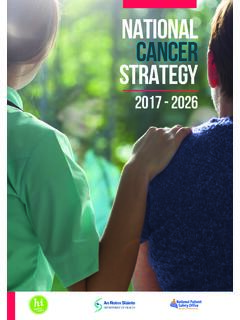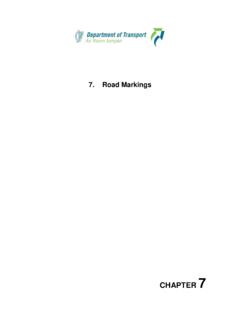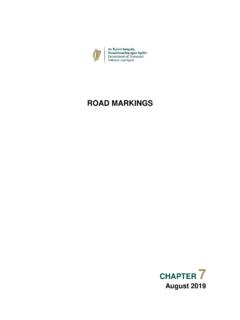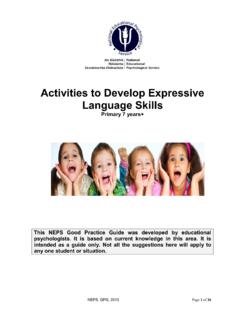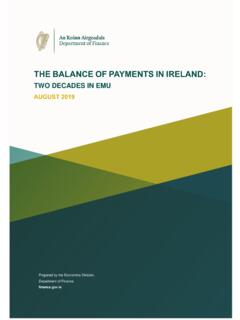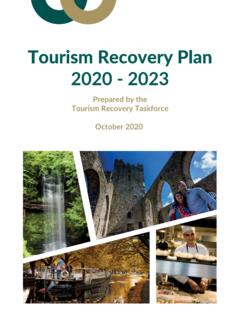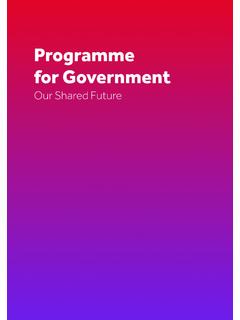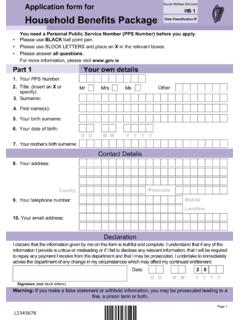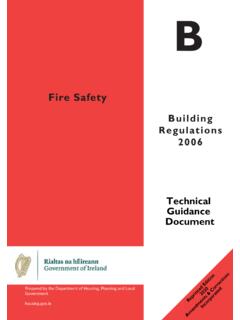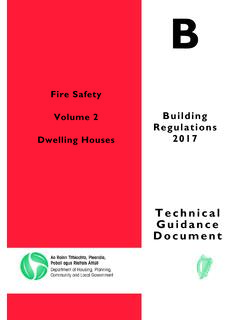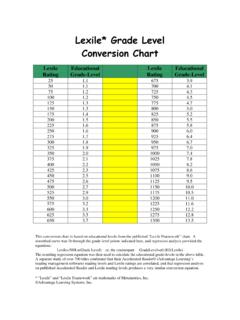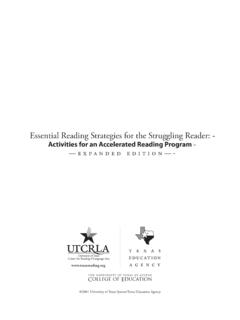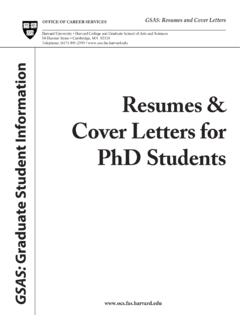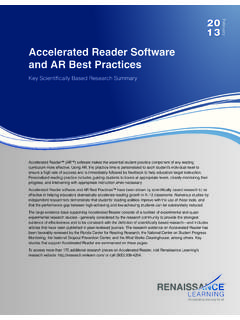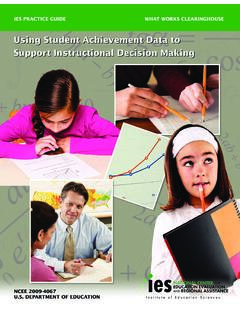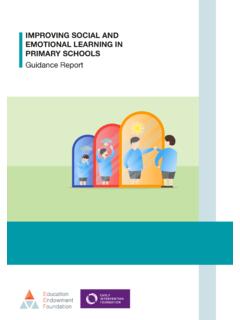Transcription of Effective Interventions for Struggling Readers
1 Effective Interventions for Struggling Readers (Second edition, 2019). A Good Practice Guide for Teachers This NEPS Good Practice Guide was developed by educational psychologists. It is based on current knowledge in this area. It is intended as a guide only. Not all the suggestions here will apply to any one student or situation. 1. Section 1 Introduction Who is this Guide for? This is a guide for teachers, particularly special education teachers, primarily those working within mainstream schools, but also relevant to those working in many special schools and classes. While classroom teachers retain overall responsibility for a student's teaching and learning, special education teachers have a key role in giving additional assistance to Struggling Readers . This guide aims to help teachers by sharing information about evidence-based approaches to teaching reading to Struggling Readers . The guide does not explore in detail specialist approaches for children with very specific diagnosis and/or high levels of need- such a braille users, profoundly deaf students, children with autism or those with severe and profound learning disabilities.
2 The guide covers the age range 6 to 18 years. It also encompasses all students with reading difficulties, including those who have dyslexia (specific learning difficulties), as well as those who have made poor progress in reading and may or may not have additional general learning difficulties. Information here can be applied to students from disadvantaged backgrounds, minority groups and to students for whom English is not a first language. While the full range of literacy involves more than just reading the focus here is particularly on reading skills: the ability to decode, read fluently and understand text. Structure of the Guide The guide is divided into the following sections: Section 1- Introduction, Defining Literacy, Context and Literature Review Section 2- Elements of Effective Reading Instruction Section 3- Organising for Effective Teaching Section 4- Assessment and Measuring Progress Section 5- Evidence-Based Interventions in Ireland Section 6- Resources to Support Struggling Readers Healthy Literacy Diet- Templates Precision Teaching Resources Teaching Sight Vocabulary and Improving Reading Fluency, A Good Practice Guide Precision Teaching Approaches and Using SNIP.
3 Checklists for First Hundred Words, Second Hundred Words and Phonics A Rough Guide to Reading Partners- A NEPS Good Practice Guide Guidance on the Use of Positive Declarations References Acronyms Appendices Acknowledgements Throughout this guide, key messages for teachers are highlighted in yellow textboxes. If you do not want to read through the more detailed information, you can move quickly from box to box, picking up these key messages about Effective teaching of reading. 2. Defining Literacy Definitions of reading and reading literacy have changed over time to reflect changes in society. Reading is no longer considered an ability acquired only in childhood. Instead it is viewed as an expanding set of knowledge, skills and strategies that individuals build on throughout life in various contexts, through interaction with their peers and the wider community. The massive growth in the use of computers and technological devices has moved literacy skills into a digital domain that requires a range of new and different skills than were needed 20 years ago.
4 To learn more about international definitions of literacy, including those of PISA, PIRLS and PIACC, see Appendix 1. Definitions of literacy are evolving and current definitions of literacy, and particularly reading literacy, emphasise a constructivist and interactive process, where Readers construct meaning from text. Literacy is seen as multi-faceted and increasingly includes digital literacy. Information about the theoretical understanding of literacy can be found in Appendix 2. The Context This resource needs to be conisdered in the context of other policy and practice documents, particularly those curriculum documents that focus on the teaching of literacy. These include: The National Literacy and Numeracy Strategy 2011-2020. The Primary Language Curriculum Junior Cycle and Post-Primary Context DES Policy and Guidance The National Literacy Strategy 2011-2020 has brought about significant improvements in the literacy skills of Irish students, both at primary and post-primary level and these gains have been documented in international studies.
5 However, further work needs to be done to raise the literacy achievements of some children in DEIS schools. To learn more about each of these areas, see: Appendix 3 The National Literacy and Numeracy Strategy 2011-2020. Appendix 4 The Primary Language Curriculum Appendix 5 Junior Cycle and Post-Primary Context Appendix 6 DES Policy and Guidance 3. What Sources of Evidence Were Used? We already know a great deal about teaching reading to students generally, and there is now a growing knowledge base about how to help students who struggle with reading. This pack collates research evidence from a range of sources and suggests how this evidence can be applied to teaching practice. This is the second edition of this resource. The first edition, published in 2012, included a synthesis of research findings drawn from twelve studies, which were characterised by rigorous methodological approaches. This edition supplements that evidence, with new up-to-date research, including research carried out in Ireland.
6 In collating this research, we have been mindful of the importance of looking at the quality of the evidence. It is sobering to read the multiple reports of the Education Endowment Foundation (EEF) in the UK. In 2018, their EEF Project Reports cover 38 literacy projects of which 42% found no effects on literacy or negative effects. Only 10 (26%) were considered promising'. This means that teachers need to be cautious about the claims made by commercial programmes and need to consider the scientific evidence to support the use of the programme. A word of caution! The quality of research varies greatly. As Brooks et al (1999) stated, it can vary from the meticulous to the appalling' (p51). Be cautious about Interventions and programmes that are supported only by glowing testimonials'. Read all research with a critical eye and look for rigorous standards in data collection. While a wide range of source material contributed to this second edition, there are three sources of information that need to be highlighted: The What Works Clearing House The Education Endowment Foundation What Works for Children and Young People with Literacy Difficulties (Brooks, 2016).
7 To learn more about each of these sources of information, see the following Appendices: Appendix 7 The What Works Clearing House Appendix 8 The Education Endowment Foundation Appendix 9 What Works for Children and Young People with Literacy Difficulties (Brooks, 2016). Data from Ireland Finally, the research strategy for this second edition included specific focus on research done in Ireland in the last five years. Accordingly, a request was issued in the summer of 2016 to all 4. universities and teacher training colleges seeking up-to-date research, which may or may not have been published. The criteria for inclusion were as follows: The intervention must have been used in Ireland The intervention must target school aged Struggling Readers (age range 5 to19 years). Struggling Readers includes all those who struggle- dyslexic type difficulties/ low general ability/ socially disadvantaged/ English as an additional language/ unexplained reading failure etc. Research data about the efficacy of the intervention must have been collected in the previous five years (2011-2016).
8 The data must include some form of standardised measurement of literacy skills (so teacher, pupil or parent opinion is not enough- there must be literacy attainments). Data can be published or unpublished, but we will need details about the source of the data, to enable us to check it thoroughly. In total, we received 23 submissions, and where those submissions fully met our criteria, they are cited in this edition. In other cases, where criteria were not fully met, but the research was deemed promising, some references are included, as relevant. In many cases, the studies are relatively small-scale and therefore the reader is advised to be cautious when interpreting the research findings. Small-scale research cannot be generalised, but it certainly offers insights into new approaches and can be helpful in expanding our knowledge base and pointing to Interventions with potential. NEPS continues to collect data about reading Interventions through its own action research activities and through collecting data from other researchers.
9 To see details of the submissions, see Appendix 10. Summary of Section 1. This guide is primarily intended to support the work of special education teachers It is presented in sections, covering key areas, with information about supporting material at the back The guide should be considered in the context of other DES advice and publications The guide is evidence-informed and includes up-to-date research evidence from major international sources Information about research in Ireland was collected using robust research criteria and 23 submissions were considered 5. Section 2. Elements of Effective Reading Instruction NEPS has produced a resource that explores Effective teaching in the Early Years, and this resource, A Balanced Approach to Literacy Development in the Early Years, contains in-depth information about best practice in the teaching of early literacy skills. This resource also gives an overview of all the elements needed for Effective reading instruction. Teachers working with Struggling Readers who are at a very early stage of development, may find some of the resources particularly helpful.
10 It is acknowledged that Early Years education is crucial for the early development of language and literacy skills. There have been recent developments in quality-assuring the Early Years sector in Ireland and the DES. Inspectorate now have a particular focus on early literacy in Early Childhood Care and Education (ECCE) settings. Elements of Effective Reading Instruction It is clear that the following elements should all form part of an Effective programme (National Reading Panel (NRP), 2000; Scammaca et al., 2007; Singleton, 2009; Kennedy et al., 2012;. Eurydice Network, 2011, Education Endowment Foundation, 2016 & 2017). An emphasis on oral language, to include vocabulary development Phonemic awareness and the teaching of phonics, decoding and word studies Learning of a sight vocabulary The explicit teaching of comprehension strategies Meaningful writing experiences The development of fluent reading with opportunities for both guided and independent reading, including informal reading activities Reading at the Just-Right' level Access to a wide-range of reading materials For those who struggle to read, there is a risk that the main purpose of being able to read becomes lost.
